Improving the Efficacy of Quinolylnitrones for Ischemic Stroke Therapy, QN4 and QN15 as New Neuroprotective Agents after Oxygen–Glucose Deprivation/Reoxygenation-Induced Neuronal Injury
Abstract
:1. Introduction
2. Results and Discussion
2.1. Design and Synthesis of New Quinolylnitrones
2.2. Neuroprotection Evaluation of QNs 1–16 in an Experimental Model of Ischemia on Primary Neuronal Cultures
2.3. Density Functional Theory (DFT) Calculations
3. Conclusions
4. Materials and Methods
4.1. Chemistry
4.1.1. General Methods
4.1.2. General Procedures
General Procedure for the Synthesis of Nitrones
General Procedure for the Synthesis of 6-Methoxy-2-(arylsulfonyl)quinoline-3-carbaldehydes 7, 8
General Procedure for the Synthesis of 6-Methoxy-2-arylquinoline-3-carbaldehydes 10, 11
4.1.3. (Z)-N-Benzyl-1-(2-chloro-6-(prop-2-yn-1-yloxy)quinolin-3-yl)methanimine Oxide (QN1)
4.1.4. (Z)-N-tert-Butyl-1-(2-chloro-6-(prop-2-yn-1-yloxy)quinolin-3-yl)methanimine Oxide (QN2)
4.1.5. (Z)-N-Benzyl-1-(6-(benzyloxy)-2-chloroquinolin-3-yl)methanimine Oxide (QN3)
4.1.6. (Z)-N-tert-Butyl-1-(6-(benzyloxy)-2-chloroquinolin-3-yl)methanimine Oxide (QN4)
4.1.7. (Z)-N-tert-Butyl-1-(2-hydroxy-6-methoxyquinolin-3-yl)methanimine Oxide (QN5)
4.1.8. (Z)-N-Benzyl-1-(6-(methoxy)-2-fluoroquinolin-3-yl)methanimine oxide (QN6)
4.1.9. (Z)-N-tert-Butyl-1-(6-(methoxy)-2-fluoroquinolin-3-yl)methanimine Oxide (QN7)
4.1.10. (Z)-N-Benzyl-1-(6-methoxy-2-(phenylsulfonyl)quinolin-3-yl)methanimine Oxide (QN8)
4.1.11. (Z)-N-tert-Butyl-1-(6-methoxy-2-(phenylsulfonyl)quinolin-3-yl)methanimine Oxide (QN9)
4.1.12. (Z)-N-Benzyl-1-(2-((4-nitrophenyl)sulfonyl)-6-methoxyquinolin-3-yl) methanimine Oxide (QN10)
4.1.13. (Z)-N-tert-Butyl-1-(2-((4-nitrophenyl)sulfonyl)-6-methoxyquinolin-3-yl) methanimine Oxide (QN11)
4.1.14. 6-Methoxy-2-(4-trifluoromethylphenyl)quinoline-3-carbaldehyde (10)
4.1.15. (Z)-N-Benzyl-1-(6-methoxy-2-(4-(trifluoromethyl)phenyl)quinolin-3-yl) methanimine Oxide (QN12)
4.1.16. (Z)-N-tert-Butyl-1-(6-methoxy-2-(4-(trifluoromethyl)phenyl)quinolin-3-yl) methanimine Oxide (QN13)
4.1.17. 6-Methoxy-2-(4-nitrophenyl)quinoline-3-carbaldehyde (11)
4.1.18. (Z)-N-Benzyl-1-(6-methoxy-2-(4-nitrophenyl)quinolin-3-yl)methanimine Oxide (QN14)
4.1.19. (Z)-N-tert-Butyl-1-(6-methoxy-2-(4-nitrophenyl)quinolin-3-yl)methanimine Oxide (QN15)
4.1.20. (Z)-N-tert-Butyl-1-(2-((E)-3-ethoxy-3-oxoprop-1-en-1-yl)-6-methoxyquinolin-3-yl)methanimine Oxide (QN16)
4.2. Neuroprotection Analysis
4.2.1. Primary Neuronal Cultures
4.2.2. Experimental Ischemia in Neuronal Cultures and Treatments
4.2.3. Cell Viability Assays
4.3. Statistical Analysis
4.4. Computational Methods
Supplementary Materials
Author Contributions
Funding
Institutional Review Board Statement
Informed Consent Statement
Data Availability Statement
Acknowledgments
Conflicts of Interest
References
- World Health Organization. Stroke, Cerebrovascular Accident. Available online: http://www.who.int/topics/cerebrovascular_accident/en/ (accessed on 13 June 2020).
- World Health Organization. Global Health Estimates 2014 Summary Tables: Deaths by Cause, Age and Sex, 2000–2012. 2014. Available online: https://www.who.int/data/gho/data/themes/mortality-and-global-health-estimates/ghe-leading-causes-of-death (accessed on 13 June 2020).
- World Health Organization. Global Health Estimates 2014 Summary Tables: DALY by Cause, Age and Sex, 2000–2012. 2014. Available online: https://www.who.int/data/gho/data/themes/mortality-and-global-health-estimates/global-health-estimates-leading-causes-of-dalys (accessed on 13 June 2020).
- Lassen, N.A.; Fieschi, C.; Lenzi, G.L. Ischemic penumbra and neuronal death: Comments on the therapeutic window in acute stroke with particular reference to thrombolytic therapy. Cerebrovasc. Dis. 1991, 1, 32–35. [Google Scholar] [CrossRef]
- Deletraz, A.; Zéamari, K.; Hua, K.; Combes, M.; Villamena, F.A.; Tuccio, B.; Callizot, N.; Durand, G. Substituted α-phenyl and α-naphthlyl-N-tert-butyl nitrones: Synthesis, spin-trapping, and neuroprotection evaluation. J. Org. Chem. 2020, 85, 6073–6085. [Google Scholar] [CrossRef] [PubMed]
- Romero, A.; Ramos, E.; Patiño, P.; Oset-Gasque, M.J.; López-Muñoz, F.; Marco-Contelles, J.; Ayuso, M.I.; Alcázar, A. Melatonin and nitrones as potential therapeutic agents for stroke. Front. Aging Neurosci. 2017, 9, 159. [Google Scholar] [CrossRef] [PubMed]
- Diez-Iriepa, D.; Chamorro, B.; Talaván, M.; Chioua, M.; Iriepa, I.; Hadjipavlou-Litina, D.; López-Muñoz, F.; Marco-Contelles, J.; Oset-Gasque, M.J. Homo-Tris-Nitrones derived from α-phenyl-N-tert-butylnitrone: Synthesis, neuroprotection and antioxidant properties. Int. J. Mol. Sci. 2020, 21, 7949. [Google Scholar] [CrossRef] [PubMed]
- Chamorro, B.; Diez-Iriepa, D.; Merás-Sáiz, B.; Chioua, M.; García-Vieira, D.; Iriepa, I.; Hadjipavlou-Litina, D.; López-Muñoz, F.; Martínez-Murillo, R.; González-Nieto, D.; et al. Synthesis, antioxidant properties and neuroprotection of α-phenyl-tert-butylnitrone derived homobisnitrones in in vitro and in vivo ischemia models. Sci. Rep. 2020, 10, 14150. [Google Scholar] [CrossRef]
- Jiménez-Almarza, A.; Diez-Iriepa, D.; Chioua, M.; Chamorro, B.; Iriepa, I.; Martínez-Murillo, R.; Hadjipavlou-Litina, D.; Oset-Gasque, M.J.; Marco-Contelles, J. Synthesis, neuroprotective and antioxidant capacity of PBN-related indanonitrones. Bioorg. Chem. 2019, 86, 445–451. [Google Scholar] [CrossRef]
- Arce, C.; Díaz-Castroverde, S.; Canales, M.J.; Marco-Contelles, J.; Samadi, A.; Oset-Gasque, M.J.; González, M.P. Drugs for stroke: Action of nitrone (Z)-N-(2-bromo-5-hydroxy-4-methoxybenzylidene)-2-methylpropan-2-amine oxide on rat cortical neurons in culture subjected to oxygen-glucose-deprivation. Eur. J. Med. Chem. 2012, 55, 475–479. [Google Scholar] [CrossRef]
- Samadi, A.; Soriano, E.; Revuelta, J.; Valderas, C.; Chioua, M.; Garrido, I.; Bartolomé, B.; Tomassolli, I.; Ismaili, L.; González-Lafuente, L.; et al. Synthesis, Structure, Theoretical and Experimental in vitro antioxidant/pharmacological properties of α-aryl, N-alkyl nitrones, as potential agents for the treatment of cerebral ischemia. Bioorg. Med. Chem. 2011, 19, 951–960. [Google Scholar] [CrossRef]
- Piotrowska, D.G.; Mediavilla, L.; Cuarental, L.; Glowacka, I.E.; Marco-Contelles, J.; Hadjipavlou-Litina, D.; López-Muñoz, F.; Oset-Gasque, M.J. Synthesis and neuroprotective properties of N-substituted C-dialkoxyphosphorylated Nitrones. ACS Omega 2019, 4, 8581–8587. [Google Scholar] [CrossRef] [PubMed] [Green Version]
- Martínez-Alonso, E.; Escobar-Peso, A.; Ayuso, M.I.; Gonzalo-Gobernado, R.; Chioua, M.; Montoya, J.J.; Montaner, J.; Fernández, I.; Marco-Contelles, J.; Alcázar, A. Characterization of a cholesteronitrone (ISQ-201), a novel drug candidate for the treatment of ischemic stroke. Antioxidants 2020, 9, 291. [Google Scholar] [CrossRef]
- Ayuso, M.I.; Chioua, M.; Martínez-Alonso, E.; Soriano, E.; Montaner, J.; Masjuan, J.; Hadjipavlou-Litina, D.; Marco-Contelles, J.; Alcázar, A. Cholesteronitrones for stroke. J. Med. Chem. 2015, 58, 6704–6709. [Google Scholar] [CrossRef] [Green Version]
- Chioua, M.; Martínez-Alonso, E.; Gonzalo-Gobernado, R.; Ayuso, M.I.; Escobar-Peso, A.; Infantes, L.; Hadjipavlou-Litina, D.; Montoya, J.J.; Montaner, J.; Alcázar, A.; et al. New quinolylnitrones for stroke therapy: Antioxidant and neuroprotective (Z)-N-tert-butyl-1-(2-chloro-6-methoxyquinolin-3-yl)methanimine oxide as a new lead-compound for ischemic stroke treatment. J. Med. Chem. 2019, 62, 2184–2201. [Google Scholar] [CrossRef] [PubMed]
- Chioua, M.; Salgado-Ramos, M.; Diez-Iriepa, D.; Escobar-Peso, A.; Iriepa, I.; Hadjipavlou-Litina, D.; Martínez-Alonso, E.; Alcázar, A.; Marco-Contelles, J. Novel Quinolylnitrones Combining Neuroprotective and Antioxidant Properties. ACS Chem. Neurosci. 2019, 10, 2703–2706. [Google Scholar] [CrossRef] [PubMed]
- Ayuso, M.I.; Martínez-Alonso, E.; Chioua, M.; Escobar-Peso, A.; Gonzalo-Gobernado, R.; Montaner, J.; Marco-Contelles, J.; Alcázar, A. Quinolinylnitrone RP19 induces neuroprotection after transient brain ischemia. ACS Chem. Neurosci. 2017, 8, 2202–2213. [Google Scholar] [CrossRef] [PubMed]
- Chioua, M.; Sucunza, D.; Soriano, E.; Hadjipavlou-Litina, D.; Alcázar, A.; Ayuso, I.; Oset-Gasque, M.J.; González, M.P.; Monjas, L.; Rodríguez-Franco, M.I.; et al. α-Aryl-N-alkyl nitrones, as potential agents for stroke treatment: Synthesis, theoretical calculations, antioxidant, anti-inflammatory, neuroprotective, and brain-blood barrier permeability properties. J. Med. Chem. 2012, 55, 153–168. [Google Scholar] [CrossRef] [PubMed] [Green Version]
- Martínez-Alonso, E.; Escobar-Peso, A.; Aliena-Valero, A.; Torregrosa, G.; Chioua, M.; Fernández-Serra, R.; González-Nieto, D.; Ouahid, Y.; Salom, J.B.; Masjuan, J.; et al. Preclinical characterization of antioxidant quinolyl nitrone QN23 as a new candidate for the treatment of ischemic stroke. Antioxidants 2022, 11, 1186. [Google Scholar] [CrossRef]
- Sun, H.; DiMagno, S.G. Room-temperature nuclophilic aromatic fluorination: Experimental and theoretical studies. Angew. Chem. Int. Ed. 2006, 45, 2720–2725. [Google Scholar] [CrossRef]
- Xie, L.-Y.; Peng, S.; Tan, J.-X.; Sun, R.-X.; Yu, X.; Dai, N.-N.; Tang, Z.-L.; Xu, X.; He, W.-M. Waste-minimized protocol for the synthesis of sulfonylated N-heteroaromatics in water. ACS Sustain. Chem. Eng. 2018, 6, 16976–16981. [Google Scholar] [CrossRef]
- Sharma, N.; Asthana, M.; Kumar, R.; Mishra, K.; Singh, R.M. rac-BINAP-PdCl2 catalyzed Heck reactions of 3-formylquinolin-2-yl chlorides with methyl acrylate: Synthesis of methyl3-(3-formylquinolin-2-yl) acrylates. Tetrahedron Lett. 2014, 55, 2348–2351. [Google Scholar] [CrossRef]
- Quevedo, C.; Salinas, M.; Alcázar, A. Initiation factor 2b activity is regulated by protein phosphatase 1, which is activated by the mitogen-activated protein kinase (mapk)-dependent pathway in insulin-like growth factor 1-stimulated neuronal cells. J. Biol. Chem. 2003, 278, 16579–16586. [Google Scholar] [CrossRef]
- Cid, C.; Alcázar, A.; Regidor, I.; Masjuán, J.; Salinas, M.; Álvarez-Cermeño, J. Neuronal apoptosis induced by cerebrospinal fluid from multiple sclerosis patients correlates with hypointense lesions on t1 magnetic resonance imaging. J. Neurol. Sci. 2002, 193, 103–109. [Google Scholar] [CrossRef]
- Althaus, J.S.; Fleck, T.J.; Becker, D.A.; Hall, E.D.; Von Voigtlander, P.F. Azulenyl nitrones: Colorimetric detection of oxyradical end products and neuroprotection in the gerbil transient forebrain ischemia/reperfusion model. Free Radic. Biol. Med. 1998, 24, 738–744. [Google Scholar] [CrossRef]
- Becker, D.A.; Ley, J.J.; Echegoyen, L.; Alvarado, R. Stilbazulenyl Nitrone (STAZN): A Nitronyl-substituted hydrocarbon with the potency of classical phenolic chain-breaking antioxidants. J. Am. Chem. Soc. 2002, 124, 4678–4684. [Google Scholar] [CrossRef] [PubMed]
- Sun, Y.; Jiang, J.; Zhang, Z.; Yu, P.; Wang, L.; Xu, C.; Liu, W.; Wang, Y. Antioxidative and thrombolytic TMP nitrone for treatment of ischemic stroke. Bioorg. Med. Chem. 2008, 16, 8868–8874. [Google Scholar] [CrossRef] [PubMed]
- Rosselin, M.; Tuccio, B.; Perio, P.; Villamena, F.A.; Fabre, P.-L.; Durand, G. Electrochemical and spin-trapping properties of para-substituted α-phenyl-N-tert-butyl nitrones. Electrochim. Acta 2016, 193, 231–239. [Google Scholar] [CrossRef]
- Kovacic, P.; Somanathan, R. Nitroaromatic compounds: Environmental toxicity, carcinogenicity, mutagenicity, therapy and mechanism. J. Appl. Toxicol. 2014, 34, 810–824. [Google Scholar] [CrossRef]
- Frisch, M.J.; Trucks, G.W.; Schlegel, H.B.; Scuseria, G.E.; Robb, M.A.; Cheeseman, J.R.; Scalmani, G.; Barone, V.; Mennucci, B.; Petersson, G.A.; et al. Gaussian 09, Revision D.01; Gaussian Inc.: Wallingford, UK, 2009. [Google Scholar]
- Becke, A.D. Density-functional thermochemistry. III. The role of exact Exchange. J. Chem. Phys. 1993, 98, 5648–5652. [Google Scholar] [CrossRef] [Green Version]
- Grimme, S.; Antony, J.; Ehrlich, S.; Krieg, H. A consistent and accurate ab initio parametrization of density functional dispersion correction (DFT-D) for the 94 elements H-Pu. J. Chem. Phys. 2010, 132, 154104/1–154104/19. [Google Scholar] [CrossRef] [Green Version]
- Weigend, F.; Ahlrichs, R. Balanced basis sets of split valence, triple zeta valence and quadruple zeta valence quality for H to Rn: Design and assessment of accuracy. Phys. Chem. Chem. Phys. 2005, 7, 3297–3305. [Google Scholar] [CrossRef]
- McIver, J.W.; Komornicki, A.K. Structure of transition states in organic reactions. General theory and an application to the cyclobutene-butadiene isomerization using a semiempirical molecular orbital method. J. Am. Chem. Soc. 1972, 94, 2625–2633. [Google Scholar] [CrossRef]
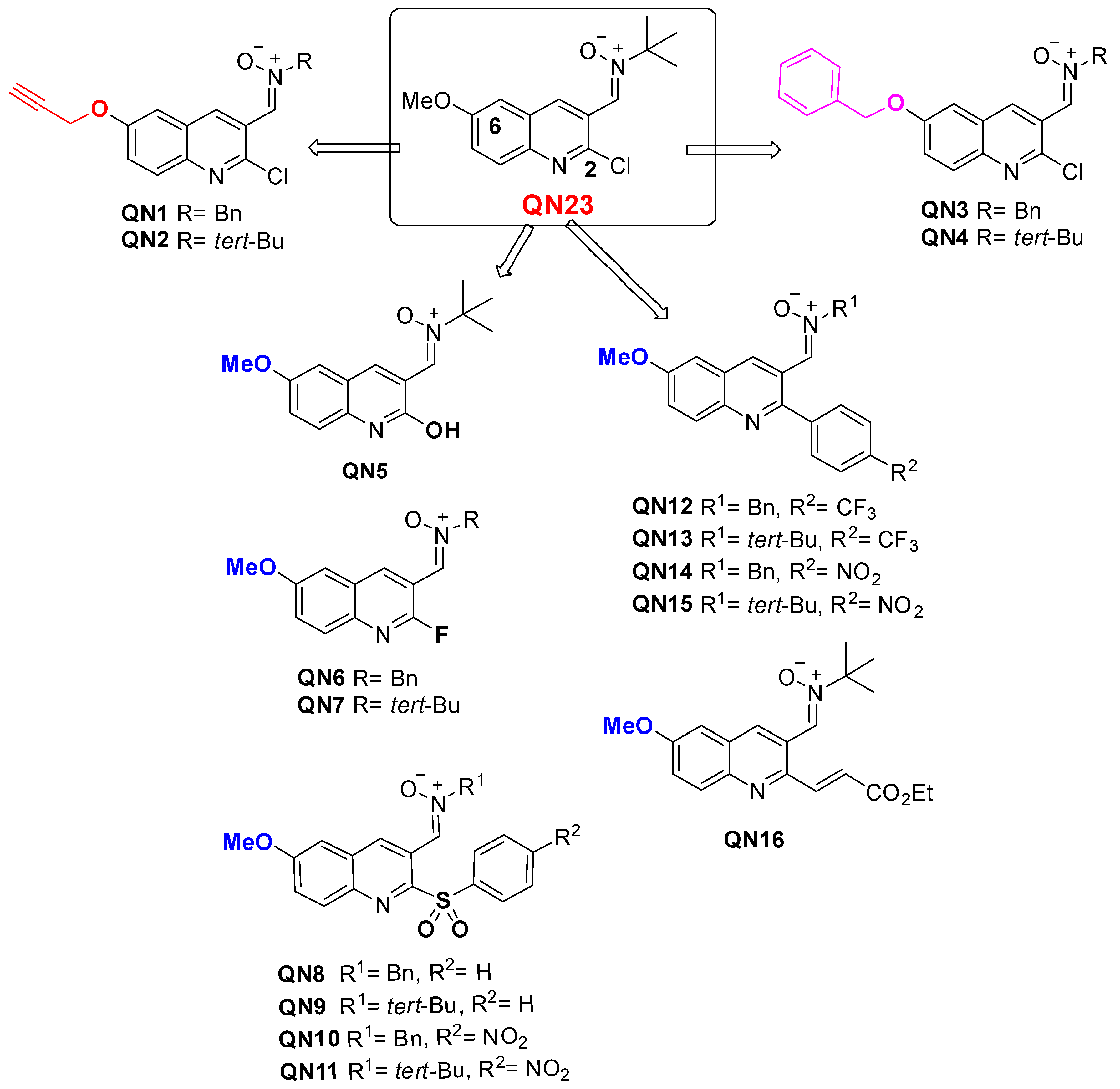

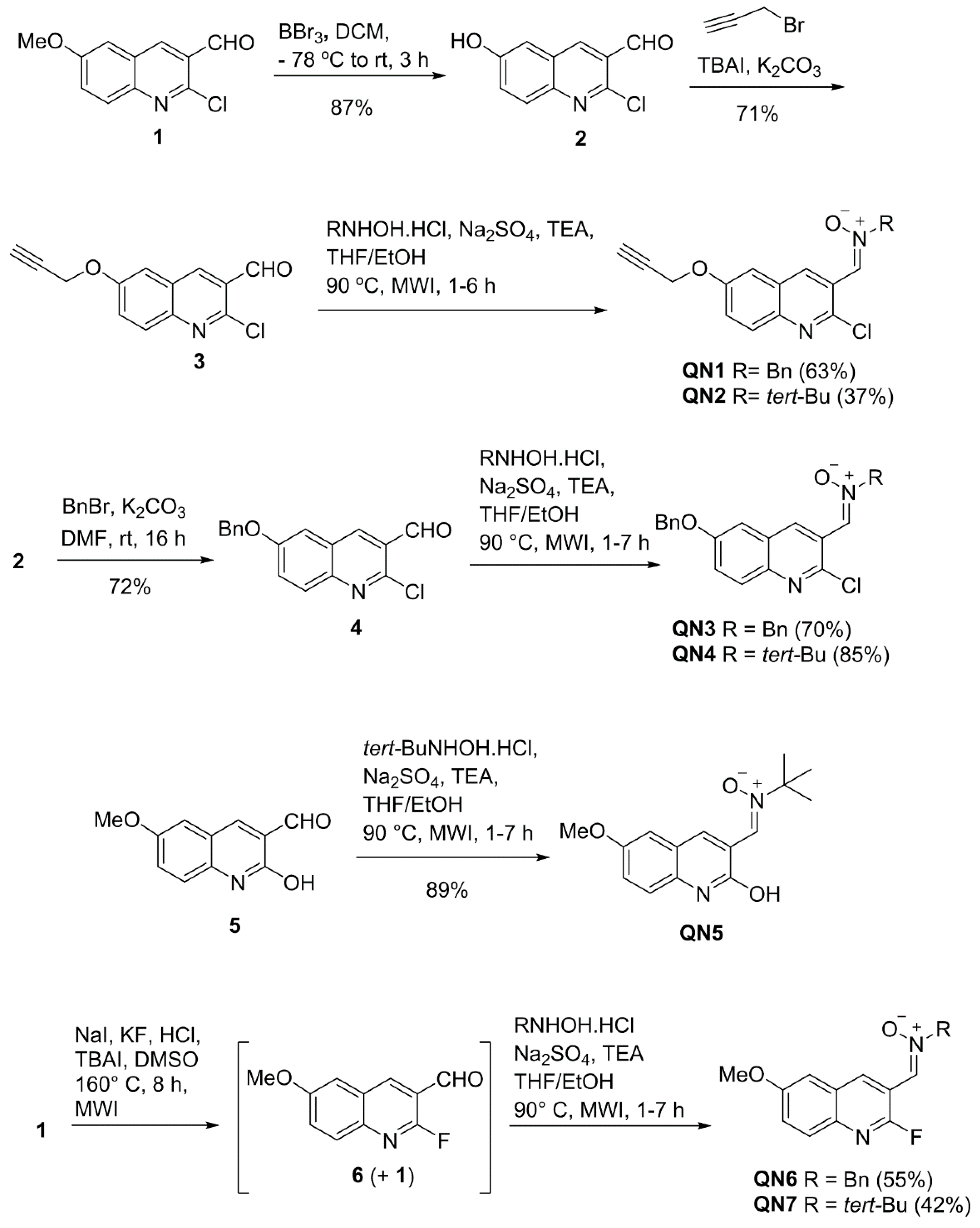
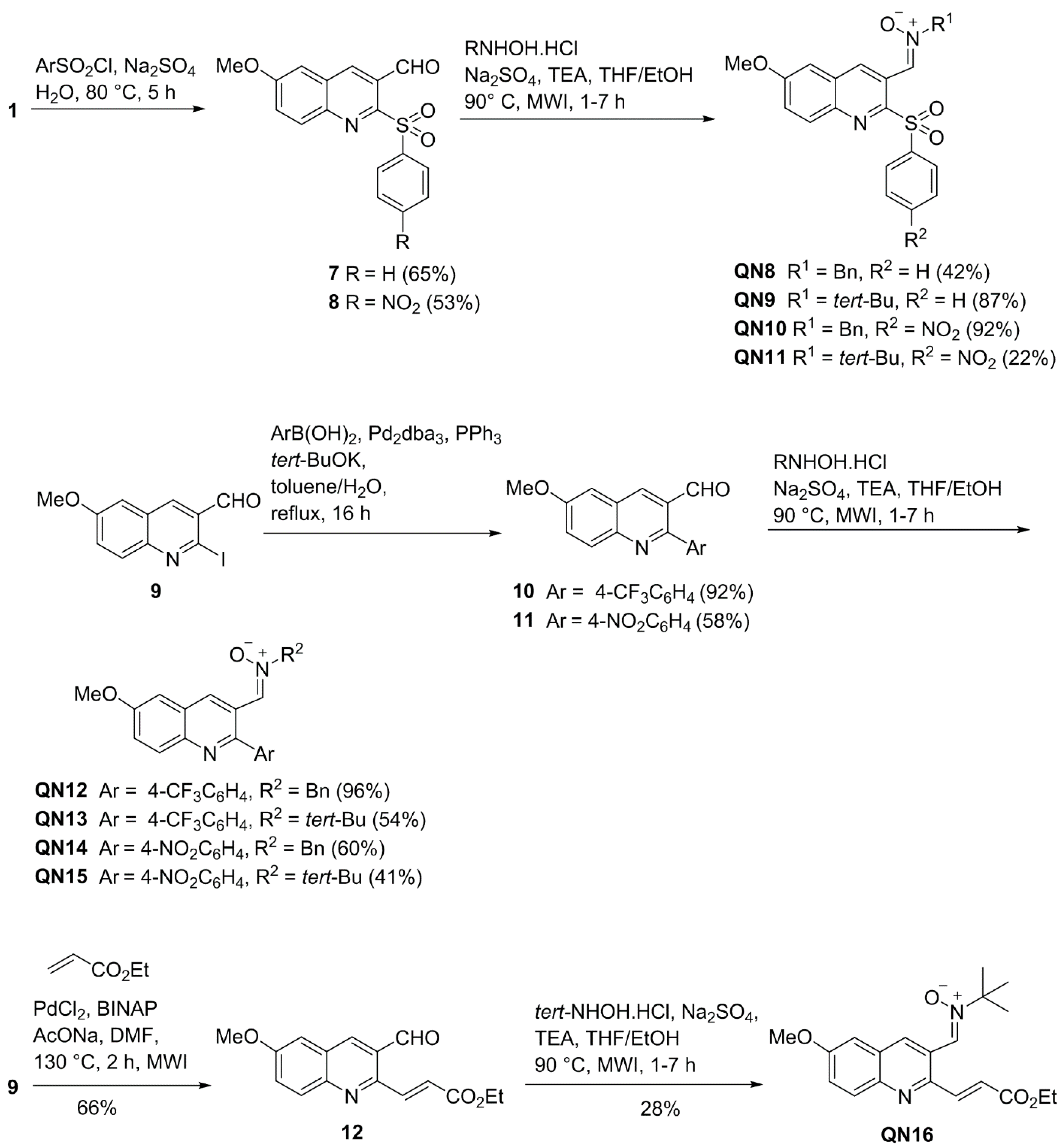
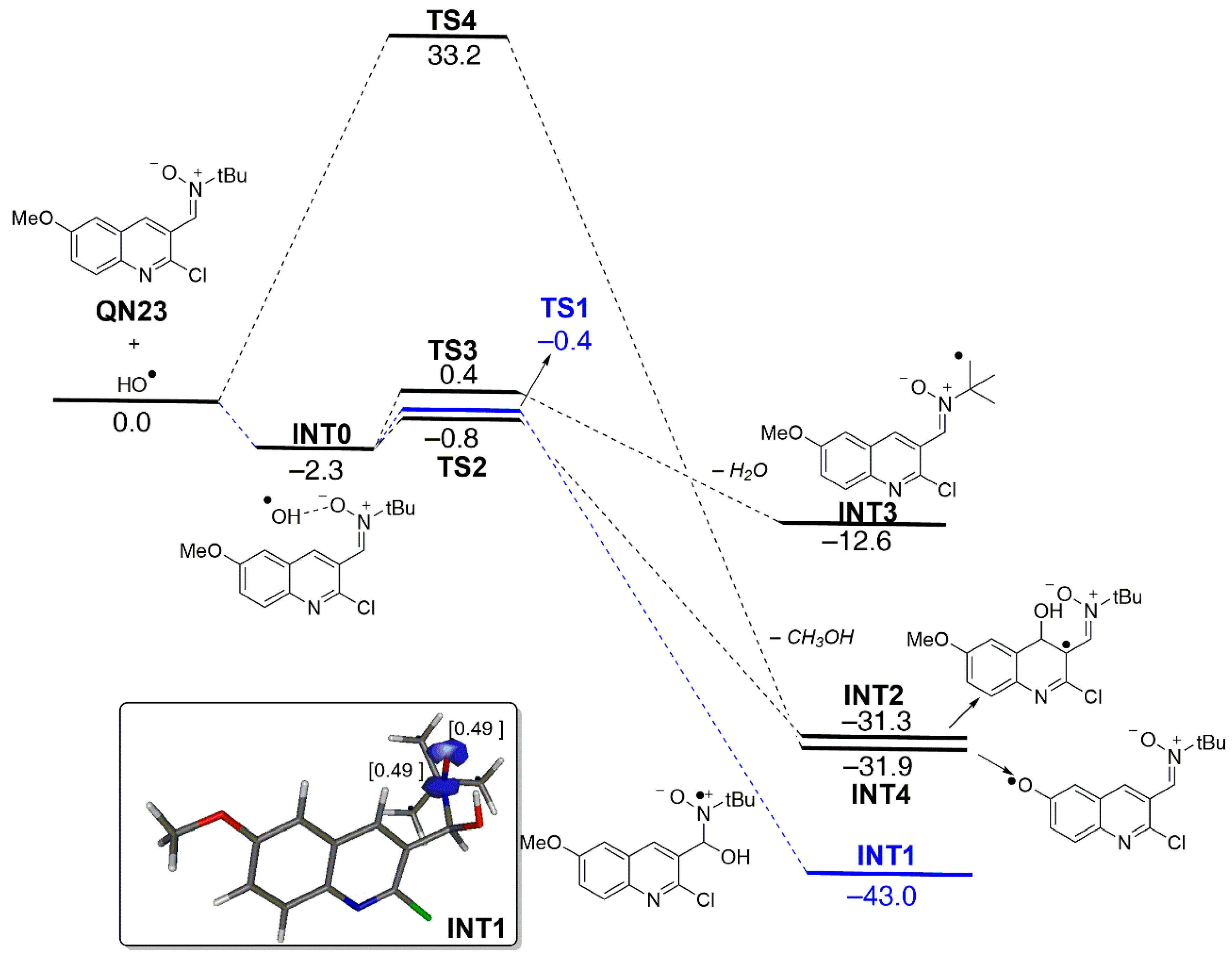
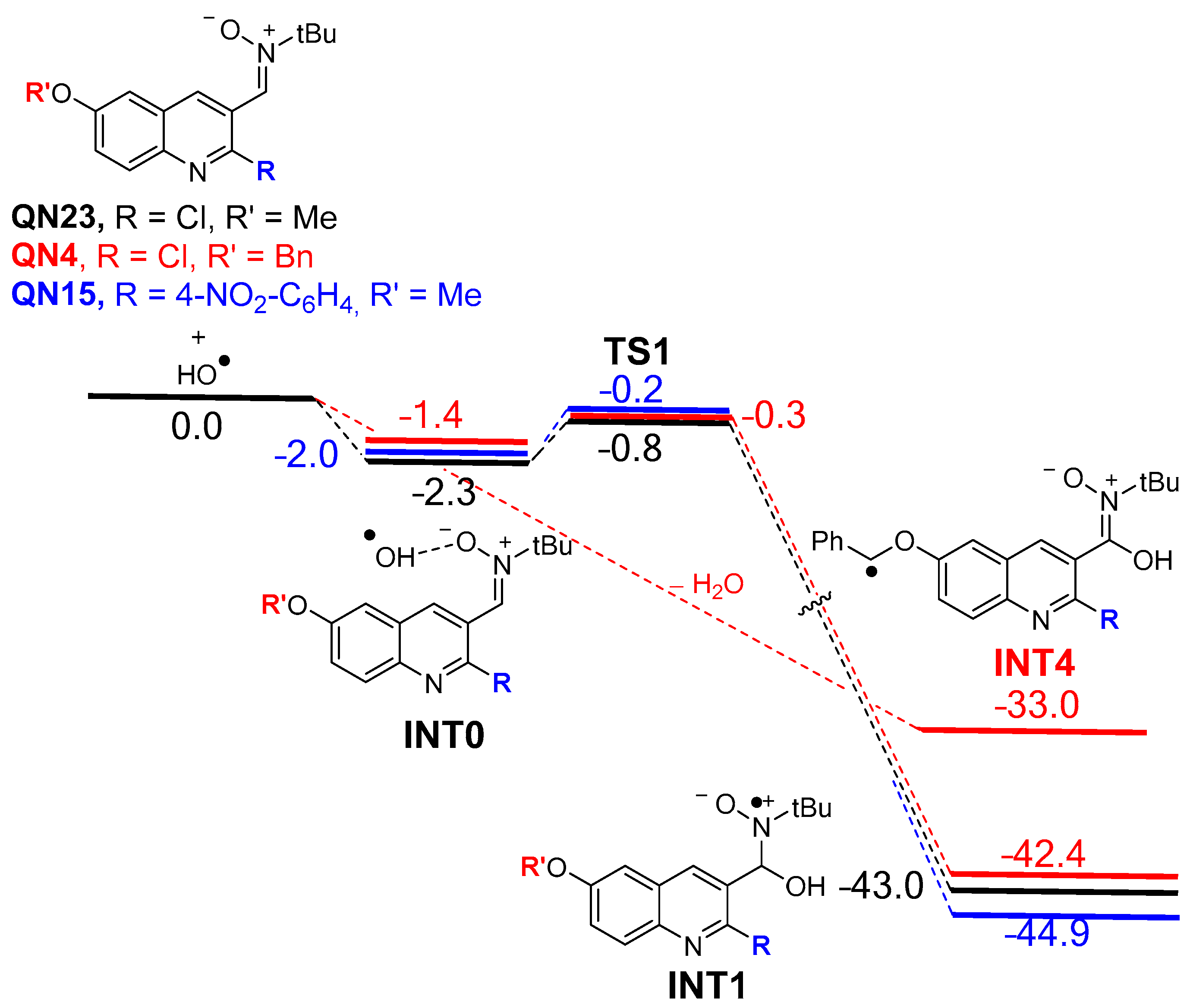
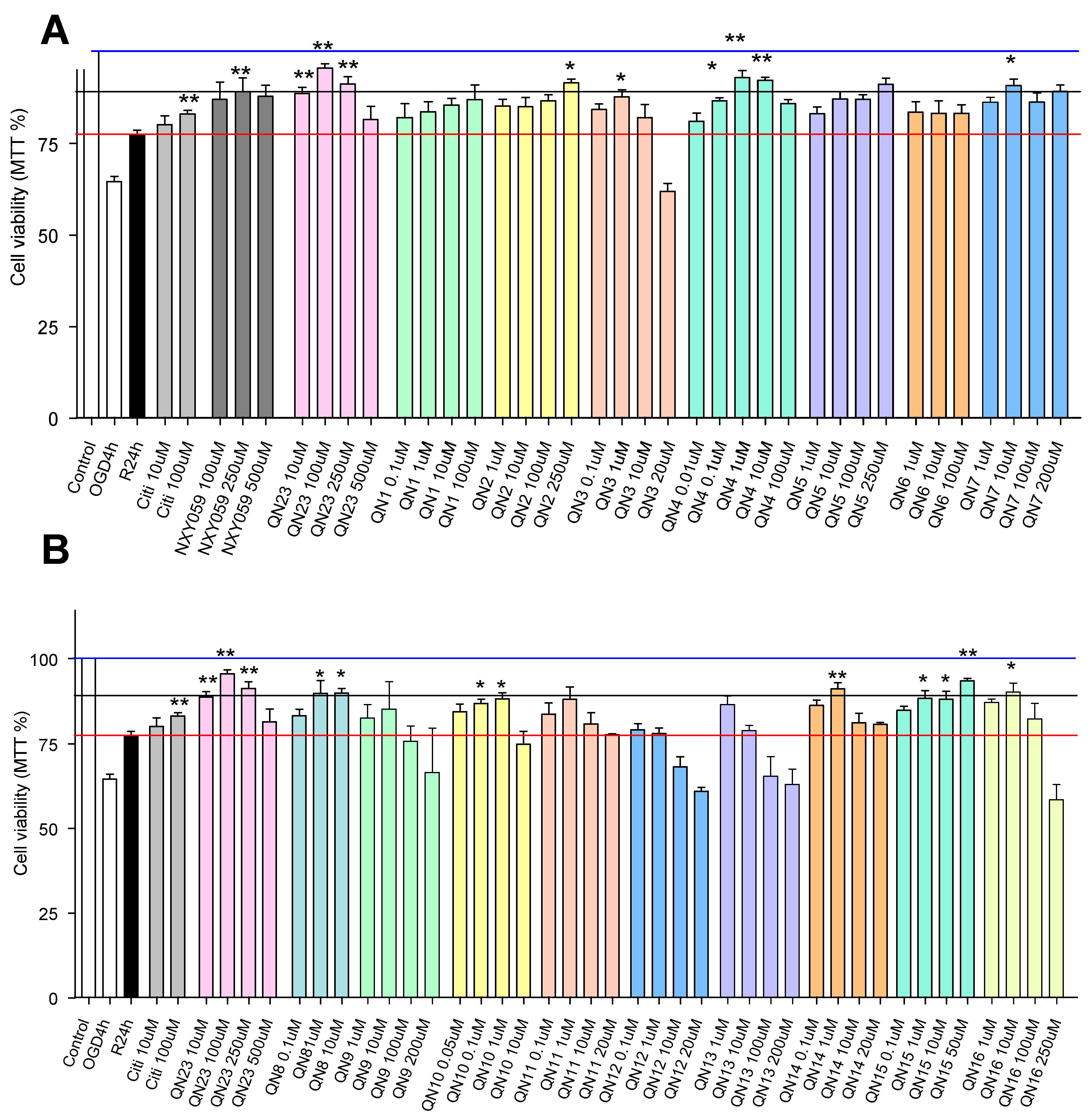

| Nitrone | Concentration (µM) | Neuroprotection (%) |
|---|---|---|
| NXY-059 | 250 | 52.90 ± 2.52 |
| QN23 | 10 | 52.03 ± 1.75 |
| 100 | 77.08 ± 2.24 *** | |
| 250 | 65.88 ± 2.87 * |
| Compound | Concentration (μM) | Neuroprotection (%) |
|---|---|---|
| NXY-059 | 100 | 41.93 ± 2.26 |
| 250 | 51.26 ± 2.12 | |
| 500 | 45.64 ± 1.56 | |
| QN23 | 10 | 49.00 ± 0.89 |
| 100 | 79.70 ± 0.98 ** | |
| 250 | 60.68 ± 1.29 ** | |
| 500 | 17.60 ± 0.77 | |
| QN2 | 1 | 33.66 ± 0.73 |
| 10 | 33.26 ± 0.93 | |
| 100 | 39.98 ± 0.77 | |
| 250 | 62.43 ± 0.59 ** | |
| QN4 | 0.01 | 15.30 ± 0.43 |
| 0.1 | 40.38 ± 0.35 | |
| 1 | 67.89 ± 1.44 ** | |
| 10 | 64.93 ± 0.57 ** | |
| 100 | 36.67 ± 0.44 | |
| QN5 | 1 | 24.50 ± 0.54 |
| 10 | 42.41 ± 0.98 | |
| 100 | 41.71 ± 0.62 | |
| 250 | 60.19 ± 1.08 * | |
| QN7 | 1 | 38.45 ± 0.62 |
| 10 | 58.64 ± 1.11 * | |
| 100 | 38.84 ± 1.10 | |
| 200 | 51.72 ± 0.99 | |
| QN15 | 0.1 | 32.42 ± 0.43 |
| 1 | 48.09 ± 1.21 | |
| 10 | 46.81 ± 1.21 | |
| 50 | 70.26 ± 0.63 * |
Publisher’s Note: MDPI stays neutral with regard to jurisdictional claims in published maps and institutional affiliations. |
© 2022 by the authors. Licensee MDPI, Basel, Switzerland. This article is an open access article distributed under the terms and conditions of the Creative Commons Attribution (CC BY) license (https://creativecommons.org/licenses/by/4.0/).
Share and Cite
Alonso, J.M.; Escobar-Peso, A.; Fernández, I.; Alcázar, A.; Marco-Contelles, J. Improving the Efficacy of Quinolylnitrones for Ischemic Stroke Therapy, QN4 and QN15 as New Neuroprotective Agents after Oxygen–Glucose Deprivation/Reoxygenation-Induced Neuronal Injury. Pharmaceuticals 2022, 15, 1363. https://doi.org/10.3390/ph15111363
Alonso JM, Escobar-Peso A, Fernández I, Alcázar A, Marco-Contelles J. Improving the Efficacy of Quinolylnitrones for Ischemic Stroke Therapy, QN4 and QN15 as New Neuroprotective Agents after Oxygen–Glucose Deprivation/Reoxygenation-Induced Neuronal Injury. Pharmaceuticals. 2022; 15(11):1363. https://doi.org/10.3390/ph15111363
Chicago/Turabian StyleAlonso, José M., Alejandro Escobar-Peso, Israel Fernández, Alberto Alcázar, and José Marco-Contelles. 2022. "Improving the Efficacy of Quinolylnitrones for Ischemic Stroke Therapy, QN4 and QN15 as New Neuroprotective Agents after Oxygen–Glucose Deprivation/Reoxygenation-Induced Neuronal Injury" Pharmaceuticals 15, no. 11: 1363. https://doi.org/10.3390/ph15111363







